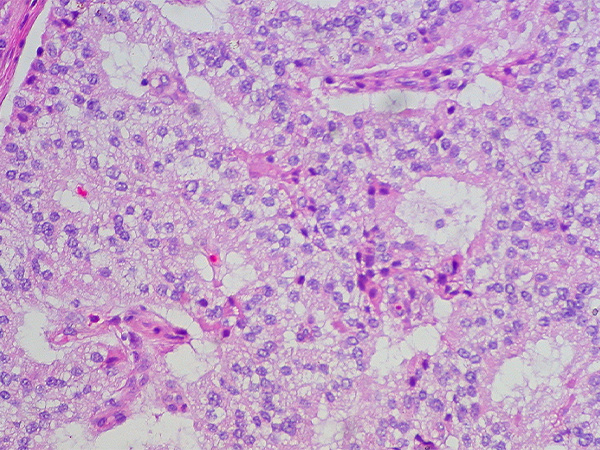Targeted Radiotherapy for Neuroendocrine Tumors
The FDA has approved a targeted radiotherapeutic for treating neuroendocrine tumors arising in the pancreas and different parts of the gastrointestinal tract.

The U.S. Food and Drug Administration (FDA) recently approved a new anticancer therapeutic called lutetium (Lu) 177 dotatate (Lutathera) for treating certain patients with neuroendocrine tumors.
Lu-177 dotatate is a targeted form of systemic radiotherapy, which means it is delivered by an IV rather than by a machine that directs beams of radiation at the tumor from outside the body. It is approved for treating adult patients who have gastroenteropancreatic neuroendocrine tumors with somatostatin receptor on the surface, like Nicole DiCamillo who is featured in the AACR Cancer Progress Report 2018.
Neuroendocrine tumors arise in cells called neuroendocrine cells, which are specialized hormone-producing cells found in most organs of the body. As a result, neuroendocrine tumors are a diverse, but rare group of cancers; according to the National Cancer Institute (NCI) there are at least 40 different types of neuroendocrine tumors.
Gastroenteropancreatic neuroendocrine tumors are neuroendocrine tumors arising in the pancreas and different parts of the gastrointestinal tract, such as the stomach, intestines, colon, and rectum. They are among the most common neuroendocrine tumors, and they include the type of cancer that Steve Jobs was diagnosed with. According to the FDA, about one in every 27,000 U.S. adults are diagnosed with a gastroenteropancreatic neuroendocrine tumor each year.
Neuroendocrine cells and therefore the cancer cells in most neuroendocrine tumors have the protein somatostatin receptor on the surface. When the hormone somatostatin attaches to somatostatin receptor on the surface of a cell, it generally has an inhibitory effect on the functions of the cell. For example, it suppresses the release of hormones by the cell.
This knowledge was first harnessed for therapeutic purposes many years ago, and analogues of somatostatin are now a common treatment for patients with metastatic neuroendocrine tumors. These therapeutics control the symptoms that arise because of the hormones released by the tumors and stabilize tumor growth. However, most tumors eventually progress, and patients have few treatment options.
One possible approach that researchers have been working on is to investigate whether they can improve the tumor-killing capacity of somatostatin analogues by linking them with radionuclides to generate a systemic radiotherapeutic.
What is Systemic Radiotherapy?
When hearing the term radiotherapy, most people think of external beam radiotherapy, which is the use of a machine to direct radiation beams such as high-energy X-rays at a cancer from outside the patient’s body. However, the term also encompasses other types of treatment, one of which is systemic radiotherapy.
Systemic radiotherapy involves the infusion or ingestion of a radioactive therapeutic that spreads throughout the body. It is important that the radioactive therapeutic is targeted to the cancer as precisely as possible to ensure that it causes limited harm to normal cells.
Lu-177 dotatate targets somatostatin receptor?positive neuroendocrine tumor cells because the radionuclide Lu-177 is linked to a somatostatin analogue. After attaching to the somatostatin receptor on the surface of a cell, Lu-177 dotatate is taken up by the cell and the radiation emitted by Lu-177 damages the cell’s DNA, destroying the cancer cell from within.
The approval of Lu-177 dotatate as a treatment for somatostatin receptor?positive gastroenteropancreatic neuroendocrine tumors was based on results from two clinical trials, according to the FDA statement. In one of the trials, the randomized phase III NETTER-1 trial, the researchers tested whether adding Lu-177 dotatate to best supportive care, which included a somatostatin analogue, improved outcomes for patients with advanced somatostatin receptor?positive gastroenteropancreatic neuroendocrine tumors.
Results from the trial, which were published in The New England Journal of Medicine, showed that median progression-free survival was significantly improved among those who received Lu-177 dotatate. The addition of Lu-177 dotatate to best supportive care also led to responses in a significantly higher percentage of patients; 18 percent of those receiving Lu-177 dotatate responded compared with 3 percent of those receiving best supportive care.
There were also half as many deaths among those receiving Lu-177 dotatate as there were among those receiving best supportive care, although these are early data and not sufficient to determine whether Lu-177 dotatate improves overall survival. As noted in a post on the NCI blog by the lead investigator of the NETTER-1 trial, Jonathan Strosberg, MD, these data suggest that the new targeted radiotherapeutic “probably does have an effect on [overall] survival. Hopefully for patients, that will be borne out in the final analysis.”
The FDA approval was rendered on January 26, 2018.
